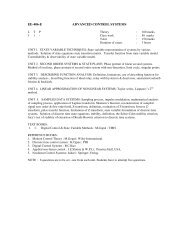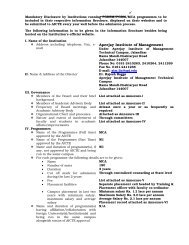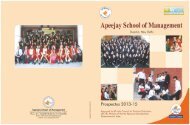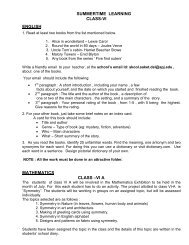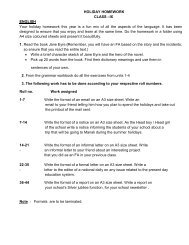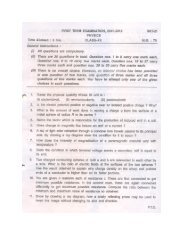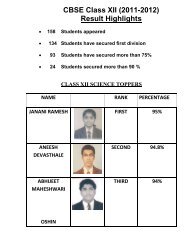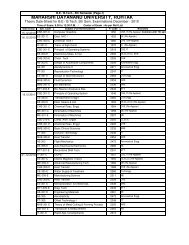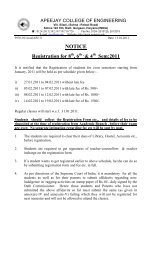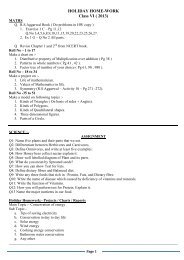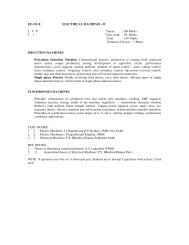Exam - Apeejay College of Engineering, Sohna
Exam - Apeejay College of Engineering, Sohna
Exam - Apeejay College of Engineering, Sohna
Create successful ePaper yourself
Turn your PDF publications into a flip-book with our unique Google optimized e-Paper software.
IT-301 ERapid Application DevelopmentL T P Class Work: 503 1 - <strong>Exam</strong>: 100Total: 150Duration <strong>of</strong> <strong>Exam</strong>: 3 Hrs.Unit-1: Visual Programming Environment: Concept <strong>of</strong> procedure and event oriented languages,Integrated Development Environment for VC++ and Visual Basic, Components <strong>of</strong> Visual C++ andVisual Basic.Unit-2: Parts <strong>of</strong> Visual C++ Program: Application object, main window object, view object,document object, Document-View architecture and its advantages, Event oriented windowsProgramming, device context, Micros<strong>of</strong>t Foundation Classes- an Overview, Simple MFCapplication, API’s .Unit-3: Reading keystrokes, handling mouse, creating menus, toolbars, buttons, status bar prompts,dialog box, check box, radio buttons, list boxes, combo boxes, sliders, multiple documents.Unit-4: Serialization, file handling, debugging.Unit-5: DLL’s, OLE Object Technologies, Creating Internet Programs using Visual C++ and VisualBasic, Creating Active X Controls, connecting to Database (using DAO/ ADO/ RDO) using VisualBasic and Visual C++.Text Books• Micros<strong>of</strong>t Visual C++ By Steven Holzner (Pub: BPB)• Visual C++ Programming, 2 nd edition by Steven Holzner(Pub: PHI)• Using Visual Basic for Applications By Paul Sanna(Pub: PHI)• Visual Basic Programming By Steven Holzner• MSDN HelpReference Books• Visual C++: From the ground Up By Mucller (Pub :TMH)• Programming Visual C++ by David J. Kruglinski
IT-303 ESystems Programming &System AdministrationL T P Class Work: 503 1 - <strong>Exam</strong>: 100Total: 150Duration <strong>of</strong> <strong>Exam</strong>: 3 Hrs.Unit-1: Evolution <strong>of</strong> Components Systems Programming, Assemblers, Loaders, Linkers, Macros,Compilers. S<strong>of</strong>tware tools, Text editors, Interpreters and program generators, Debug Monitors,Programming environment.Unit-2: Compiler: Brief overview <strong>of</strong> compilation process, Incremental compiler, Assembler:Problem statement, single phase and two phase assembler, symbol table; Loader schemes, compileand go Loader, general loader schemes, absolute loader, Subroutine linkage, Reallocating loader,Direct linkage Loader, Binders, Linking loader, overlays.Unit-3: Macro language and macro-processor, macro instructions, features <strong>of</strong> macr<strong>of</strong>acility, macro instruction arguments, conditional macro expansion, macro calls with macroinstruction defining macros.Unit-4: Theoretical Concept <strong>of</strong> UNIX Operating System: Basic features <strong>of</strong> operating system;File structure: CPU scheduling; Memory management: swapping, demand paging; file system: blockand fragments, inodes, directory structure; User to user communication.Unit-5: Getting Started with UNIX: User names and groups, logging in; Format <strong>of</strong> UNIXcommands; Changing your password; Characters with special meaning; UNIX documentation; Filesand directories; Current directory, looking at the directory contents, absolute and relative pathnames,some UNIX directories and files; Looking at the file contents; File permissions; basic operation onfiles; changing permission modes; Standard files, standard output; Standard input, standard error;filters and pipelines; Processes; finding out about processes; Stopping background process; UNIXeditor vi.Unit-6: Test Manipulation: Inspecting files; File statistics; Searching for patterns; Comparingfiles; Operating on files; Printing files; Rearranging files; Sorting files; Splitting files; Translatingcharacters; AWK utility.Unit-7: Shell Programming: Programming in the Borne and C-Shell; Wild cards; Simple shellprograms; Shell variables; Shell programming constructs; interactive shell scripts; Advancedfeatures.Unit-8: System Administration: Definition <strong>of</strong> system administration; Booting the system;Maintaining user accounts; File systems and special files; Backups and restoration; Role andfunctions <strong>of</strong> a system manager.Overview <strong>of</strong> the Linux. Operating systemText Books:• Systems Programming by Donovan, TMH.• The UNIX programming environment by Brain Kernighen & Rob Pike, 1984, PHI & Rob Pike.• Design <strong>of</strong> the UNIX operating system by Maurich Bach, 1986, PHI.• Introduction to UNIX and LINUX by John Muster, 2003, TMH.Reference Book:• Advanced Unix programmer’s Guide by Stephen Prato, BPB• UNIX- Concept and applications by Sumitabha Das, 2002, T.M..HNote:Eight questions will be set in all by the examiners taking at least one question from each unit. Studentswill be required to attempt five questions in all.
IT-305 EComputer NetworksL T P Class Work: 503 1 - <strong>Exam</strong>: 100Total: 150Duration <strong>of</strong> <strong>Exam</strong>: 3 Hrs.Unit-1: OSI Reference Model and Network Architecture: Introduction to Computer Networks,<strong>Exam</strong>ple networks ARPANET, Internet, Private Networks, Network Topologies: Bus-, Star-, Ring-,Hybrid -, Tree -, Complete -, Irregular –Topology; Types <strong>of</strong> Networks : Local Area Networks,Metropolitan Area Networks, Wide Area Networks; Layering architecture <strong>of</strong> networks, OSI model,Functions <strong>of</strong> each layer, Services and Protocols <strong>of</strong> each layerUnit–2: TCP/IP: Introduction, History <strong>of</strong> TCP/IP, Layers <strong>of</strong> TCP/IP, Protocols, Internet Protocol,Transmission Control Protocol , User Datagram Protocol, IP Addressing, IP address classes, SubnetAddressing, Internet Control Protocols, ARP, RARP, ICMP, Application Layer, Domain NameSystem, Email – SMTP, POP,IMAP; FTP, NNTP, HTTP, Overview <strong>of</strong> IP version 6.Unit-3: Local Area Networks: Introduction to LANs, Features <strong>of</strong> LANs, Components <strong>of</strong> LANs,Usage <strong>of</strong> LANs, LAN Standards, IEEE 802 standards, Channel Access Methods, Aloha, CSMA,CSMA/CD, Token Passing, Ethernet, Layer 2 & 3 switching, Fast Ethernet and Gigabit Ethernet,Token Ring, LAN interconnecting devices: Hubs, Switches, Bridges, Routers, Gateways.Unit–4: Wide Area Networks: Introduction <strong>of</strong> WANs, Routing, Congestion Control, WANTechnologies, Distributed Queue Dual Bus (DQDB), Synchronous Digital Hierarchy (SDH)/Synchronous Optical Network (SONET), Asynchronous Transfer Mode (ATM), FrameRelay.,Wireless Links.Unit-5: Introduction to Network Management: Remote Monitoring Techniques: Polling, Traps,Performance Management, Class <strong>of</strong> Service, Quality <strong>of</strong> Service, Security management, Firewalls,VLANs, Proxy Servers, Introduction to Network Operating Systems: Client-Server infrastructure,Windows NT/2000.Text Book:• Computer Networks (3rd edition), Tanenbaum Andrew S., International edition, 1996.Reference Books:• Data Communications, Computer Networks and Open Systems (4th edition), Halsall Fred,2000, Addison Wesley, Low Price Edition.• Business Data Communications, Fitzgerald Jerry,.• Computer Networks – A System Approach, Larry L. Peterson & Bruce S. Davie, 2 nd Edition• Computer Networking – ED Tittel , 2002, T.M.H.Note:Eight questions will be set in all by the examiners taking at least one question fromeach unit. Students will be required to attempt five questions in all.
CSE-301 EPrinciples <strong>of</strong> Operating SystemsL T P Class Work: 503 1 - <strong>Exam</strong>: 100Total: 150Duration <strong>of</strong> <strong>Exam</strong>: 3 Hrs.Unit-1: Introduction: Introduction to Operating System Concepts (including Multitasking,multiprogramming, multi user, Multithreading etc)., Types <strong>of</strong> Operating Systems: Batch operatingsystem, Time-sharing systems, Distributed OS, Network OS, Real Time OS; Various Operatingsystem services, architecture, System programs and calls.Unit–2: Process Management: Process concept, process scheduling, operation on processes; CPUscheduling, scheduling criteria, scheduling algorithms -First Come First Serve (FCFS), Shortest-Job-First (SJF), Priority Scheduling, Round Robin(RR), Multilevel Queue Scheduling.Unit–3: Memory Management: Logical & Physical Address Space, swapping, contiguousmemory allocation, non-contiguous memory allocation paging and segmentation techniques,segmentation with paging; virtual memory management - Demand Paging & Page-ReplacementAlgorithms; Demand Segmentation.Unit–4: File System: Different types <strong>of</strong> files and their access methods, directory structures, variousallocation methods, disk scheduling and management and its associated algorithms, Introduction todistributed file system.Unit–5: Process-Synchronization & Deadlocks: Critical Section Problems, semaphores; methodsfor handling deadlocks-deadlock prevention, avoidance & detection; deadlock recovery.Unit-6: I/O Systems: I/O Hardware, Application I/O Interface, Kernel, Transforming I/O requests,Performance Issues.Unit–7: UNIX System and Windows NT OverviewUNIX system call for processes and file system management, Shell interpreter, Windows NTarchitecture overview, Windows NT file system.Text Books:• Operating System Concepts by Silberchatz et al, 5 th edition, 1998, Addison-Wesley.• Modern Operating Systems by A. Tanenbaum, 1992, Prentice-Hall.• Operating Systems Internals and Design Principles by William Stallings,4 th edition, 2001,Prentice-HallReference Books:• Operating System by Peterson , 1985, AW.• Operating System by Milankovic, 1990, TMH.• Operating System Incorporating With UNIX & Windows by Colin Ritche, 1974, TMH.• Operating Systems by Mandrik & Donovan, TMH• Operating Systems by Deitel, 1990, AWL.• Operating Systems – Advanced Concepts By Mukesh Singhal , N.G. Shivaratri, 2003, T.M.HNote:Eight questions will be set in all by the examiners taking at least one question fromeach unit. Students will be required to attempt five questions in all.
EE-309-EMICROPROCESSORS AND INTERFACINGL T P CLASS WORK : 503 1 0 EXAM : 100TOTAL : 150DURATION OF EXAM : 3 HRSPART AUNIT1. THE 8085 PROCESSOR :Introduction to microprocessor, 8085 microprocessor: Architecture, instruction set, interruptsstructure, and assembly language programming.UNIT2. THE 8086 MICROPROCESSOR ARCHITECTURE:Architecture, block diagram <strong>of</strong> 8086, details <strong>of</strong> sub-blocks such as EU, BIU; memory segmentationand physical address computations, program relocation, addressing modes, instruction formats, pindiagram and description <strong>of</strong> various signals.UNIT3. INSTRUCTION SET OF 8086:Instruction execution timing, assembler instruction format, data transfer instructions, arithmeticinstructions, branch instructions, looping instructions, NOP and HLT instructions, flag manipulationinstructions, logical instructions, shift and rotate instructions, directives and operators, programmingexamples.PART BUNIT4. INTERFACING DEVICE :The 8255 PPI chip: Architecture, control words, modes and examples.UNIT 5. DMA :Introduction to DMA process, 8237 DMA controller,UNIT6. INTERRUPT AND TIMER :8259 Programmable interrupt controller, Programmable interval timer chips.TEXT BOOKS :1. Microprocessor Architecture, Programming & Applications with 8085 : Ramesh S Gaonkar;Wiley Eastern Ltd.2. The Intel Microprocessors 8086- Pentium processor : Brey; PHIREFERENCE BOOKS:1. Microprocessors and interfacing : Hall; TMH2. The 8088 & 8086 Microprocessors-Programming, interfacing, Hardware & Applications :Triebel& Singh; PHI3. Microcomputer systems: the 8086/8088 Family: architecture, Programming & Design : Yu-Chang Liu & GlennA Gibson; PHI.4. Advanced Microprocessors and Interfacing : Badri Ram; TMHNOTE: 8 questions are to be set selecting FIVE questions from PART A and THREE questionsfrom PART- B .Students have to attempt any five questions.
CSE -303 EComputer GraphicsL T P Class Work: 503 1 - <strong>Exam</strong>: 100Total: 150Duration <strong>of</strong> <strong>Exam</strong>: 3 Hrs.Unit-1: Introduction to Computer Graphics: What is Computer Graphics, Computer GraphicsApplications, Computer Graphics Hardware and s<strong>of</strong>tware, Two dimensional Graphics Primitives:Points and Lines, Line drawing algorithms: DDA, Bresenham’s; Circle drawing algorithms: Usingpolar coordinates, Bresenham’s circle drawing, mid point circle drawing algorithm; Filled areaalgorithms: Scanline: Polygon filling algorithm, boundary filled algorithm.Unit-2: Two/Three Dimensional Viewing: The 2-D viewing pipeline, windows, viewports,window to view port mapping; Clipping: point, clipping line (algorithms):- 4 bit code algorithm,Sutherland-cohen algorithm, parametric line clipping algorithm (Cyrus Beck).Polygon clipping algorithm: Sutherland-Hodgeman polygon clipping algorithm. Two dimensionaltransformations: transformations, translation, scaling, rotation, reflection, composite transformation.Three dimensional transformations: Three dimensional graphics concept, Matrix representation <strong>of</strong> 3-D Transformations, Composition <strong>of</strong> 3-D transformation.Unit-3: Viewing in 3D: Projections, types <strong>of</strong> projections, the mathematics <strong>of</strong> planner geometricprojections, coordinate systems.Unit-4: Hidden surface removal: Introduction to hidden surface removal. The Z- bufferalgorithm, scanline algorithm, area sub-division algorithm.Unit-5: Representing Curves and Surfaces: Parametric representation <strong>of</strong> curves: Beziercurves, B-Spline curves. Parametric representation <strong>of</strong> surfaces; Interpolation method.Unit-6: Illumination, shading, image manipulation: Illumination models, shading models forpolygons, shadows, transparency. What is an image? Filtering, image processing, geometrictransformation <strong>of</strong> images.Text Books:• Computer Graphics Principles and Practices second edition by James D. Foley, Andeies van Dam,Stevan K. Feiner and Johb F. Hughes, 2000, Addision Wesley.• Computer Graphics by Donald Hearn and M.Pauline Baker, 2 nd Edition, 1999, PHIReference Books:• Procedural Elements for Computer Graphics – David F. Rogers, 2001, T.M.H Second Edition• Fundamentals <strong>of</strong> 3Dimensional Computer Graphics by Alan Watt, 1999, Addision Wesley.• Computer Graphics: Secrets and Solutions by Corrign John, BPB• Graphics, GUI, Games & Multimedia Projects in C by Pilania & Mahendra, Standard Publ.• Computer Graphics Secrets and solutions by Corrign John, 1994, BPV• Introduction to Computer Graphics By N. Krishanmurthy T.M.H 2002Note:Eight questions will be set in all by the examiners taking at least one question from each unit.Students will be required to attempt five questions in all.
IT-307 ERapid Application Development Lab.L T P Class Work: 25- - 2 <strong>Exam</strong>: 25Total: 50Duration <strong>of</strong> <strong>Exam</strong>: 3 Hrs.Note: At least 10 experiments are to be performed by the students in the semester1. Study window’s API’s? Find out their relationship with MFC classes. Appreciate how theyare helpful in finding complexities <strong>of</strong> window’s programming?2. Get familiar with the essential classes in a typical (document view architecture) VC programand their relationships with each other.3. Write a program to handle the mouse event right click on client area and display a messagebox as “Right Button Click”.4. Create a simple model dialog box to read the information about a student i.e. name, roll no.class using appropriate fields.5. Write a simple console application to create archive class object from file class that readsand stores a simple structure (record).6. Create a simple database in MS access and connect it to Visual Basic using ADO or DAO.7. Write a program that reads a text and changes its font, font size as selected by the user fromdifferent fonts contained in a list box.8. With the help <strong>of</strong> Visual Basic, created an object <strong>of</strong> excel application and implement anyfunction <strong>of</strong> it.9. Write a simple program that displays an appropriate message when an illegal operation isperformed, using error handling technique in VB.10. Make an active X control <strong>of</strong> your own using Visual Basic.
CSE-309 EComputer Graphics Lab.L T P Class Work: 50- - 3 <strong>Exam</strong>: 50Total: 100Duration <strong>of</strong> <strong>Exam</strong>: 3 Hrs.List <strong>of</strong> programs to be developed1. Write a program for 2D line drawing as Raster Graphics Display.2. Write a program for circle drawing as Raster Graphics Display.3. Write a program for polygon filling as Raster Graphics Display4. Write a program for line clipping.5. Write a program for polygon clipping.6. Write a program for displaying 3D objects as 2D display using perspective transformation.7. Write a program for rotation <strong>of</strong> a 3D object about arbitrary axis.8. Write a program for Hidden surface removal from a 3D object.Note:At least 5 to 10 more exercises to be given by the teacher concerned.
CSE-313 EOperating Systems Lab.L T P Class Work: 25- - 2 <strong>Exam</strong>: 25Total: 50Duration <strong>of</strong> <strong>Exam</strong>: 3 Hrs.• Study <strong>of</strong> WINDOWS 2000 Operating System.• Administration <strong>of</strong> WINDOWS 2000 (including DNS,LDAP, Directory Services)• Study <strong>of</strong> LINUX Operating System (Linux kernel, shell, basic commands pipe & filtercommands).• Administration <strong>of</strong> LINUX Operating System.• Writing <strong>of</strong> Shell Scripts (Shell programming).• AWK programming.Note: At least 5 to 10 more exercises to be given by the teacher concerned.
EE-329-EMICROPROCESSORS AND INTERFACING LABL T P CLASS WORK : 250 0 2 EXAM : 25TOTAL : 50DURATION OF EXAM : 3 HRSLIST OF EXPERIMENTS:1. Study <strong>of</strong> 8085 Microprocessor kit.2. Write a program using 8085 and verify for :a. Addition <strong>of</strong> two 8-bit numbers.b. Addition <strong>of</strong> two 8-bit numbers (with carry).3. Write a program using 8085 and verify for :a. 8-bit subtraction (display borrow)b. 16-bit subtraction (display borrow)4. Write a program using 8085 for multiplication <strong>of</strong> two 8- bit numbers by repeated additionmethod. Check for minimum number <strong>of</strong> additions and test for typical data.5. Write a program using 8085 for multiplication <strong>of</strong> two 8- bit numbers by bit rotation method andverify.6. Write a program using 8085 for division <strong>of</strong> two 8- bit numbers by repeated subtraction methodand test for typical data.7. Write a program using 8085 for dividing two 8- bit numbers by bit rotation method and test fortypical data.8. Study <strong>of</strong> 8086 microprocessor kit9. Write a program using 8086 for division <strong>of</strong> a defined double word (stored in a data segment) byanother double Word division and verify.10. Write a program using 8086 for finding the square root <strong>of</strong> a given number and verify.11. Write a program using 8086 for copying 12 bytes <strong>of</strong> data from source to destination and verify.12. Write a program using 8086 and verify for:a. Finding the largest number from an array.b. Finding the smallest number from an array.13. Write a program using 8086 for arranging an array <strong>of</strong> numbers in descending order and verify.14. Write a program using 8086 for arranging an array <strong>of</strong> numbers in ascending order and verify.15. Write a program for finding square <strong>of</strong> a number using look-up table and verify. .16. Write a program to interface a two digit number using seven-segment LEDs. Use 8085/8086microprocessor and 8255 PPI.
17. Write a program to control the operation <strong>of</strong> stepper motor using 8085/8086 microprocessor and8255 PPI.NOTE: At least ten experiments have to be performed in the semester out <strong>of</strong> which sevenexperiments should be performed from above list. Remaining three experiments may either beperformed from the above list or designed & set by the concerned institution as per the scope <strong>of</strong> thesyllabus <strong>of</strong> EE-309-C.
IT-302 ENetwork ProgrammingL T P Class Work: 503 1 - <strong>Exam</strong>: 100Total: 150Duration <strong>of</strong> <strong>Exam</strong>: 3 Hrs.Unit-1: Introduction to networking, TC/IP Protocol architecture, Classful internet addresses,subnets, super netting, address resolution Protocol (RAP) and RARP, IP datagram format, UDP andTCP/data grams , ICMP its purpose , FINGER, NET STAT details & IPconfig, Ping, TRACERT,ROUTE.Unit-2: Socket introduction, elementary TCP sockets, TCP client sever, I/O functions, select& pollfunctions, socket options elementary UDP sockets, elementary node and address conversions, echoservice (TCP and UDP).Unit-3: Algorithm and issues in server s<strong>of</strong>tware design :iterative connectionless servers, (UDP),Iterative, connection oriented servers (TCP), single process, concurrent servers multiprotocolservers (TCP,UDP), multi service servers (TCP,UDP).Unit-4: Remote procedure call concept (RCP) :RPC models, analogy between RPC <strong>of</strong> client andserver, remote programs and procedures, their multiple versions and mutual exclusioncommunication semantics, RPC retransmits, dynamic port mapping ,authentication.Unit-5: Network file system concept <strong>of</strong> data link access, debugging techniques ,Routing sockets,broadcasting to mobile network.Text Books:• Unix Network programming Vol -2 nd edition, W.Richard Stevens• Internet working with TCP/IP Vol-1, Doubles e-commer.• Internetworking TCP/IP Vol III Doubles E comer, David L.StevensReference Book:• Internetworking with TCP/IP, Vol IINote:Eight questions will be set in all by the examiners taking at least one question fromeach unit. Students will be required to attempt five questions in all.
CSE-302 EPrinciples <strong>of</strong> S<strong>of</strong>tware <strong>Engineering</strong>L T P Class Work: 503 1 - <strong>Exam</strong>: 100Total: 150Duration <strong>of</strong> <strong>Exam</strong>: 3 Hrs.Unit-1: Introduction: The process, s<strong>of</strong>tware products, emergence <strong>of</strong> s<strong>of</strong>tware engineering, evolving role <strong>of</strong>s<strong>of</strong>tware, s<strong>of</strong>tware life cycle models, S<strong>of</strong>tware Characteristics, Applications, S<strong>of</strong>tware crisis.Unit-2 : S<strong>of</strong>tware project management: Project management concepts, s<strong>of</strong>tware process and project metricsProject planning, project size estimation metrics, project estimation Techniques, empirical estimationtechniques, COCOMO- A Heuristic estimation techniques, staffing level estimation, team structures, staffing,risk analysis and management, project scheduling and tracking.Unit-3 : Requirements Analysis and specification requirements engineering, system modeling and simulationAnalysis principles modeling, partitioning S<strong>of</strong>tware, prototyping: , Prototyping methods and tools; Specificationprinciples, Representation, the s<strong>of</strong>tware requirements specification and reviews Analysis Modeling: DataModeling, Functional modeling and information flow: Data flow diagrams, Behavioral Modeling; The mechanics<strong>of</strong> structured analysis: Creating entity/ relationship diagram, data flow model, control flow model, the controland process specification; The data dictionary; Other classical analysis methods.Unit-4: System Design: Design concepts and principles: the design process: Design and s<strong>of</strong>tware quality,design principles; Design concepts: Abstraction, refinement, modularity, s<strong>of</strong>tware architecture, controlhierarchy, structural partitioning, data structure, s<strong>of</strong>tware procedure, information hiding; Effective modulardesign: Functional independence, Cohesion, Coupling; Design Heuristics for effective modularity; The designmodel; Design documentation.Architectural Design: S<strong>of</strong>tware architecture, Data Design: Data modeling, data structures, databases andthe data warehouse, Analyzing alternative Architectural Designs ,architectural complexity; Mappingrequirements into a s<strong>of</strong>tware architecture; Transform flow, Transaction flow; Transform mapping: Refiningthe architectural design.Unit-5 : Testing and maintenance: S<strong>of</strong>tware Testing Techniques, s<strong>of</strong>tware testing fundamentals: objectives,principles, testability; Test case design, white box testing, basis path testing: Control structure testing: Blackbox testing, testing for specialized environments ,architectures and applications. S<strong>of</strong>tware Testing Strategies:Verification and validation, Unit testing, Integration testing,; Validation testing, alpha and beta testing;System testing: Recovery testing, security testing, stress testing, performance testing; The art <strong>of</strong> debugging,the debugging process debugging approaches. S<strong>of</strong>tware re-engineering , reverse engineering ,restructuring,forward engineering.Unit-6 : S<strong>of</strong>tware Reliability and Quality Assurance :Quality concepts, S<strong>of</strong>tware quality assurance , SQAactivities; S<strong>of</strong>tware reviews: cost impact <strong>of</strong> s<strong>of</strong>tware defects, defect amplification and removal; formaltechnical reviews: The review meeting, review reporting and record keeping, review guidelines; Formalapproaches to SQA; Statistical s<strong>of</strong>tware quality assurance; s<strong>of</strong>tware reliability: Measures <strong>of</strong> reliability andavailability ,The ISO 9000 Quality standards: The ISO approach to quality assurance systems, The ISO 9001standard, S<strong>of</strong>tware Configuration Management.Unit-7: Computer Aided s<strong>of</strong>tware <strong>Engineering</strong>: CASE, building blocks, integrated case environments andarchitecture, repository.Text Book:• S<strong>of</strong>tware <strong>Engineering</strong> – A Practitioner’s Approach, Roger S. Pressman, 1996, MGH.Reference Books:• Fundamentals <strong>of</strong> s<strong>of</strong>tware <strong>Engineering</strong>, Rajib Mall, PHI• S<strong>of</strong>tware <strong>Engineering</strong> by Ian sommerville, Pearson Edu, 5 th edition, 1999, AW,• S<strong>of</strong>tware <strong>Engineering</strong> – David Gustafson, 2002, T.M.H• S<strong>of</strong>tware <strong>Engineering</strong> Fundamentals Oxford University, Ali Behforooz and Frederick J. Hudson 1995JW&S,• An Integrated Approach to s<strong>of</strong>tware engineering by Pankaj jalote , 1991 Narosa,Note: Eight questions will be set in all by the examiners taking at least one question fromeach unit. Students will be required to attempt five questions in all.
CSE-304 EIntelligent SystemsL T P Class Work: 503 1 - <strong>Exam</strong>: 100Total: 150Duration <strong>of</strong> <strong>Exam</strong>: 3 Hrs.Unit-1: Foundational issues in intelligent systems: Foundation and history <strong>of</strong> AI, Ai problems andtechniques – AI programming languages, introduction to LISP and PROLOG- problem spaces andsearches, blind search strategies, Breadth first- Depth first- heuristic search techniques Hill climbing:best first- A * algorithm AO* algorithm- game tree, Min max algorithms, game playing- alpha betapruning.Unit-2: Knowledge representation issues, predicate logic- logic programming, semantic netsframesand inheritance, constraint propagation, representing knowledge using rules, rules baseddeduction systems.Unit-3: Reasoning under uncertainty, review <strong>of</strong> probability, Baye’s probabilistic interferences andDempster shafer theory, Heuristic methods, symbolic reasoning under uncertainty, Statisticalreasoning, Fuzzy reasoning, Temporal reasoning, Non monotonic reasoning.Unit-4: Planning, planning in situational calculus, representation for planning, partial orderplanning algorithm, learning from examples, discovery as learning, I earning by analogy,explanation based learning, neural nets, genetic algorithms.Unit-5: Principles <strong>of</strong> Natural language processing, rule based systems architecture, Expert systems,knowledge acquisition concepts, AI application to robotics, and current trends in intelligent systems.Text Book:• Artificial Intelligence: A Modern Approach,. Russell & Norvig. 1995, Prentice Hall.Reference Books:• Artificial Intelligence, Elain Rich and Kevin Knight, 1991, TMH.• Artificial Intelligence-A modern approach, Staurt Russel and peter norvig, 1998, PHI.• Artificial intelligence, Patrick Henry Winston:, 1992, Addition Wesley 3 rd Ed.,Note:Eight questions will be set in all by the examiners taking at least one question fromeach unit. Students will be required to attempt five questions in all.
CSE- 307 EWeb DevelopmentL T P Class Work: 503 1 - <strong>Exam</strong>: 100Total: 150Duration <strong>of</strong> <strong>Exam</strong>: 3 Hrs.Unit-1: Introduction to the Internet, The world wide web: The idea <strong>of</strong> hypertext and hypermedia; How the web works-HTTP, HTML and URLs; How the browser works-MIME types,plugins and helper applications; The standards-HTML, XML, XHTML and the W3C.Hypertext markup language: The anatomy <strong>of</strong> an HTML document; Marking up for structureand style: basic page markup, absolute and relative links, ordered and unordered lists, embeddingimages and controlling appearance, table creation and use, frames, nesting and targeting.Descriptive markup: Meta tags for common tasks, semantic tags for aiding search, the doublincore and RDF.Unit-2: Separating style from structure with style sheets: Internal style specifications withinHTML, External linked style specification using CSS, page and site design considerations.Client side programming: Introduction to the JavaScript syntax, the JavaScript object model,Event handling, Output in JavaScript, Forms handling, miscellaneous topics such as cookies,hidden fields, and images; Applications.Unit-3: Server side programming: Introduction to Server Side Technologies CGI/ASP/JSP.,Programming languages for server Side Scripting, Configuring the server to support CGI,applications; Input/ output operations on the WWW, Forms processing, (usingPERL/VBSCRIPT/JavaSCIPT)Unit-4: Other dynamic content technologies: introduction to ASP & JSP, Deliveringmultimedia over web pages, The VRML idea, The Java phenomenon-applets and servelets,issues and web development.Unit-5: Introduction to Micros<strong>of</strong>t .NET Technology and its comparison with the competingTechnologies.Text books:• Beginning XHTML by Frank Boumpery, Cassandra Greer, Dave Raggett, Jenny Raggett, SebastianSchnitzenbaumer & ted Wug<strong>of</strong>ski, 2000, WROX press (Indian Shr<strong>of</strong>f Publ. SPD) 1 st edition• HTML & XHTML: The Definitive Guide by Chuck Musciano, Bill Kennedy, 2000, 4 th Edi.Reference books:• XHTML Black Book by Steven Holzner, 2000• CGI Programming on the World Wide Web. O’Reilly Associates.• Web Technologies By Achyut S Godbole , Atul Kahate, 2003, T.M.H• Scott Guelich, Shishir Gundararam, Gunther Birzniek; CGI Programing with Perl 2/e O’Reilly.• Doug Tidwell, James Snell, Pavel Kulchenko; Programming Web services, O’Reilly.• Intranets by James D.Cimino, 1997, Jaico Publ.• Internet and Web Technologies – Raj Kamal, 2002, T.M.HNote:Eight questions will be set in all by the examiners taking at least one question from each unit. Studentswill be required to attempt five questions in all.
EE-402-EWIRELESS COMMUNICATIONL T P CLASS WORK : 503 1 0 EXAM : 100TOTAL : 150DURATION OF EXAM : 3 HRSUNIT 1. INTRODUCTION TO WIRELESS COMMUNICATION SYSTEMS:Evolution <strong>of</strong> mobile radio communications, examples <strong>of</strong> wireless comm. systems, paging systems,Cordless telephone systems, comparison <strong>of</strong> various wireless systems.UNIT 2. MODERN WIRELESS COMMUNICATION SYSTEMS:Second generation cellular networks, third generation wireless networks, wireless in local loop,wireless local area networks, Blue tooth and Personal Area networks.UNIT 3. INTRODUCTION TO CELLULAR MOBILE SYSTEMS:Spectrum Allocation, basic Cellular Systems, performance Criteria, Operation <strong>of</strong> cellular systems,analog cellular systems, digital Cellular Systems.UNIT 4. ELLULAR SYSTEM DESIGN FUNDAMENTALS:Frequency Reuse, channel assignment strategies, hand<strong>of</strong>f Strategies, Interference and systemcapacity, tracking and grade <strong>of</strong>f service, improving coverage and capacity.UNIT 5. MULTIPLE ACCESS TECHNIQUES FOR WIRELESS COMMUNICATION:Introduction to Multiple Access, FDMA, TDMA, Spread Spectrum multiple Access, space divisionmultiple access, packet ratio, capacity <strong>of</strong> a cellular systems.UNIT 6. WIRELESS NETWORKING:Difference between wireless and fixed telephone networks, development <strong>of</strong> wireless networks, fixednetwork transmission hierarchy, traffic routing in wireless networks, wireless data services, commonchannel signaling, ISDN (Integrated Services digital Networks), advanced intelligent networks.UNIT 7. INTELLIGENT CELL CONCEPT AND APPLICATION:Intelligent cell concept, applications <strong>of</strong> intelligent micro-cell Systems, in-Building Communication,CDMA cellular Radio Networks.TEXT BOOKS:1. Wireless Communications: Theodore S. Rappaport; Pearsons.2. Mobile Cellular Telecommunication: W.C.Y.Lee; McGraw HillREFERENCE BOOK:1. Mobile Communications: Jochen Schiller; PearsonNOTE: Eight questions are to be set -one question from each unit. Students have to attempt any fivequestion.
EE-407-EDIGITAL SIGNAL PROCESSINGL T P CLASS WORK : 503 1 0 EXAM : 100TOTAL : 150DURATION OF EXAM : 3 HRSUNIT1. DISCRETE-TIME SIGNALS:Signal classifications, frequency domain representation, time domain representation, representation<strong>of</strong> sequences by Fourier transform, properties <strong>of</strong> Fourier transform, discrete time random signals,energy and power theorems.UNIT2. DISCRETE-TIME SYSTEMS : Classification, properties, time invariant system,finite impulse Response (FIR) system, infinite impulse response (IIR) system.UNIT3. SAMPLING OF TIME SIGNALS:Sampling theorem, application, frequency domain representation <strong>of</strong> sampling, reconstruction <strong>of</strong> bandlimited signal from its samples. discrete time processing <strong>of</strong> continuous time signals, changing thesampling rate using discrete time processing.UNIT4. Z-TRANSFORM :Introduction, properties <strong>of</strong> the region <strong>of</strong> convergence, properties <strong>of</strong> the Z-transform, inversion <strong>of</strong> theZ-transform, applications <strong>of</strong> Z-transform.UNIT5. BASICS OF DIGITAL FILTERS : Fundamentals <strong>of</strong> digital filtering, various types <strong>of</strong>digital filters, design techniques <strong>of</strong> digital filters : window technique for FIR, bi-lineartransformation and backward difference methods for IIR filter design, analysis <strong>of</strong> finite word lengtheffects in DSP, DSP algorithm implementation consideration. Applications <strong>of</strong> DSP.UNIT6. MULTIRATE DIGITAL SIGNAL PROCESSING:Introduction to multirate digital signal processing, sampling rate conversion, filter structures,multistage decimator and interpolators, digital filter banks.TEXT BOOKS :1. Digital Signal Processing : Proakis and Manolakis; PHI2. Digital Signal Processing: Salivahanan, Vallavaraj and Gnanapriya;TMHREFERENCE BOOKS:1. Digital Signal Processing: Alon V. Oppenhelm;PHI2. Digital Signal processing(II-Edition): Mitra, TMHNOTE: Eight questions are to be set - at least one from each unit. Students have to attempt fivequestions.
IT-304 ENetwork Programming Lab.L T P Class Work: 25- - 2 <strong>Exam</strong>: 25Total: 50Duration <strong>of</strong> <strong>Exam</strong>: 3 Hrs.The socket programming can be done on Unix/Linux operating or/and Windows. Socketprogramming, and the language can be C/VC++ and/or Java1. Write a program to Create Sockets For Sending And Receiving Data.2. Write a program to Obtain The Local & Remote Socket Address.3. Write a program to Create Sockets For Handling Multiple Connection4. Write a program to Obtain The Information About The (A) Host (B) Network (C) Protocols(D) Domains5. Write a program to Manipulate The IP Address.6. Write a program to Write A Telnet Client.7. Write a program to Make An FTP ClientNote:At least 5 to 10 more exercises to be given by the teacher concerned.
CSE-306 EIntelligent System Lab.L T P Class Work: 25- - 2 <strong>Exam</strong>: 25Total: 50Duration <strong>of</strong> <strong>Exam</strong>: 3 Hrs.1. Study <strong>of</strong> PROLOG.Write the following programs using PROLOG.2. Write a program to solve 8 queens problem.3. Solve any problem using depth first search.4. Solve any problem using best first search.5. Solve 8-puzzle problem using best first search6. Solve Robot (traversal) problem using means End Analysis.7. Solve traveling salesman problem.Note:At least 5 to 10 more exercises to be given by the teacher concerned.
CSE-311 EWeb Development & Core JAVA Lab.L T P Class Work: 25- - 2 <strong>Exam</strong>: 25Total: 50Duration <strong>of</strong> <strong>Exam</strong>: 3 Hrs.Java programs using classes & objects and various control constructs such as loops etc , and datastructures such as arrays , structures and functions.Java programs for creating Applets for display <strong>of</strong> Images ,Texts and AnimationPrograms related to interfaces & packagesInput output & Random files programs in javaJava programs using Event driven conceptPrograms related to Network ProgrammingDevelopment <strong>of</strong> Web site for the college or newspaper agency.Books recommended for Lab.• Java Elements – Principles <strong>of</strong> Programming in Java , Duane A. Bailey , DuaneW. Bailey, 2000, T.M.H• The Java Handbook by Patrick Naughton, TMH, N.Delhi



